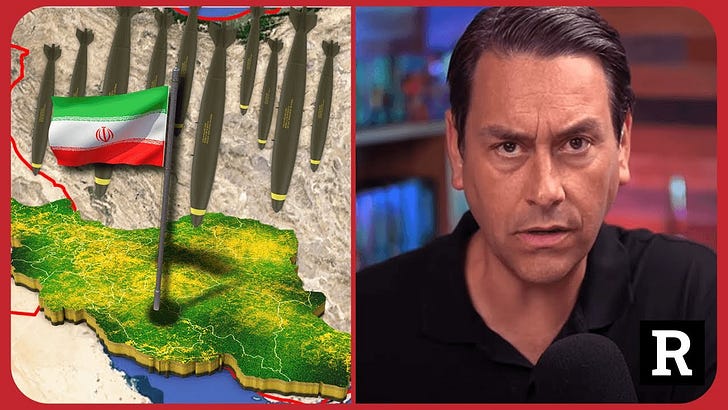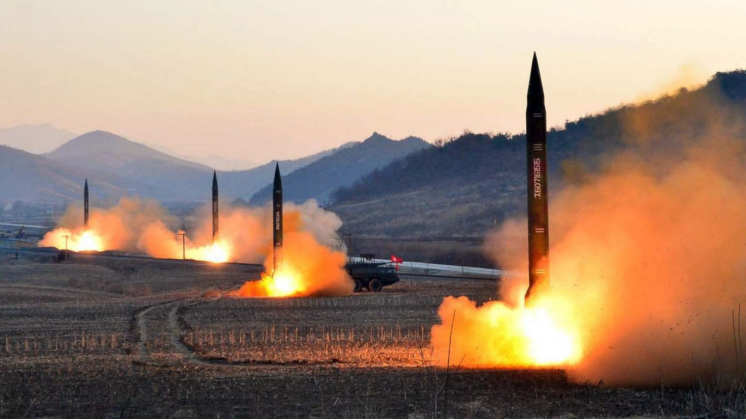US Marine Scott Ritter: "As an American I'm am SCARED over what's about to happen"
In one of the most important interviews I have heard, Scott Ritter reveals the truth of the successful Iranian attack on Israel and some facts I did not know about the targets chosen by Iran.
I did not know, for instance, that one of the airfields targeted was Israeli-American and housed weapons that were supposed to target missile attacks like this.
I did not know that Iranian drones have technology to evade anti-missile defence.
Footage reveals Iranian missiles skillfully maneuvering to evade the Israeli Iron Dome air defense systems and successfully reaching their intended targets after flying over 2000 kilometers.
Scott Ritter: The Missiles of April
The “Missiles of April” represent a sea-change moment in Middle Eastern geopolitics — the establishment of Iranian deterrence that impacts both Israel and the United States.
Iranian missiles passing over Al-Aqsa as IRGC hit Israel with multiple airstrikes on Sunday morning local time. (Unknown/Mehrnews.com/Wikimedia Commons)
By Scott Ritter
April 15, 2024
I’ve been writing about Iran for more than two decades. In 2005, I made a trip to Iran to ascertain the “ground truth” about that nation, a truth which I then incorporated into a book, Target Iran, laying out the U.S.-Israeli collaboration to craft a justification for a military attack on Iran designed to bring down its theocratic government.
I followed this book up with another, Dealbreaker, in 2018, which brought this U.S.-Israeli effort up to date.
Back in November 2006, in an address to Columbia University’s School of International Relations, I underscored that the United States would never abandon my “good friend” Israel until, of course, we did. What could precipitate such an action, I asked?
I noted that Israel was a nation drunk of hubris and power, and unless the United States could find a way to remove the keys from the ignition of the bus Israel was navigating toward the abyss, we would not join Israel in its lemming-like suicidal journey.
The next year, in 2007, during an address to the American Jewish Committee, I pointed out that my criticism of Israel (which many in the audience took strong umbrage against) came from a place of concern for Israel’s future.
I underscored the reality that I had spent the better part of a decade trying to protect Israel from Iraqi missiles, both during my service in Desert Storm, where I played a role in the counter-SCUD missile campaign, and as a United Nations weapons inspector, where I worked with Israeli intelligence to make sure Iraq’s SCUD missiles were eliminated.
“The last thing I want to see,” I told the crowd, “is a scenario where Iranian missiles were impacting on the soil of Israel. But unless Israel changes course, this is the inevitable outcome of a policy driven more by arrogance than common sense.”
On Monday night, early Tuesday morning, April 13-14, my concerns were played out live before an international audience — Iranian missiles rained down on Israel, and there was nothing Israel could do to stop them.
As had been the case a little more than 33 years prior, when Iraqi SCUD missiles overcame U.S. and Israeli Patriot missile defenses to strike Israel dozens of times over the course of a month and a half, Iranian missiles, integrated into a plan of attack which was designed to overwhelm Israeli missile defense systems, struck designated targets inside Israel with impunity.
Despite having employed an extensive integrated anti-missile defense system comprised of the so-called “Iron Dome” system, U.S.-made Patriot missile batteries, and the Arrow and David’s Sling missile interceptors, along with U.S., British, and Israeli aircraft, and U.S. and French shipborne anti-missile defenses, well over a dozen Iranian missiles struck heavily-protected Israeli airfields and air defense installations.
The Iranians hit at least two runways, taking them out of service, and at least five warehouse-type structures (this from satellite imagery taken after the attack.)
Iran gave Israel a five-hour advance warning to move high value items (F-35s). Moreover, Iran did not attack barracks, headquarters, or targets that would produce casualties.
The damage may have been minor, but the message is clear — Iran can hit any target it wants to, at any time.
Israel Had Hit Iranian Territory
Iranian consulate in Damascus after it was hit with an Israeli airstrike on April 1. (Unknown/Rajannews.com/Wikimedia.com)
The Iranian missile attack on Israel did not come out of the blue, so to speak, but rather was retaliation for an April 1 Israeli attack on the Iranian consulate building, in Damascus, Syria, that killed several senior Iranian military commanders.
While Israel has carried out attacks against Iranian personnel inside Syria in the past, the April 1 strike differed by not only killing very senior Iranian personnel, but by striking what was legally speaking sovereign Iranian territory — the Iranian consulate.
From an Iranian perspective, the attack on the consulate was a redline which, if not retaliated against, would erase any notion of deterrence, opening the door for even more brazen Israeli military action, up to and including direct attacks on Iran.
Weighing against retaliation, however, were a complex web of interwoven policy objectives which would probably be mooted by the kind of large-scale conflict between Israel and Iran that could be precipitated by any meaningful Iranian retaliatory strike on Israel.
First and foremost, Iran has been engaged in a strategic policy premised on a pivot away from Europe and the United States, and toward Russia, China, and the Eurasian landmass.
This shift has been driven by Iran’s frustration over the U.S.-driven policy of economic sanctions, and the inability and/or unwillingness on the part of the collective West to find a path forward that would see these sanctions lifted.
The failure of the Iranian nuclear deal (the Joint Comprehensive Plan of Action, or JCPOA) to produce the kind of economic opportunities that had been promised at its signing has been a major driver behind this Iranian eastward pivot.
In its stead, Iran has joined both the Shanghai Cooperation Organization (SCO) and the BRICS forum and has directed its diplomatic energies into seeing Iran thoroughly and productively integrated into both groups.
A general war with Israel would play havoc on these efforts.
Secondly, but no less important in the overall geopolitical equation for Iran, is the ongoing conflict in Gaza. This is a game-changing event, where Israel is facing strategic defeat at the hands of Hamas and its regional allies, including the Iranian-led axis of resistance.
For the first time ever, the issue of Palestinian statehood has been taken up by a global audience.
This cause is further facilitated by the fact that the Israeli government of Benjamin Netanyahu, formed from a political coalition which is vehemently opposed to any notion of Palestinian statehood, finds itself in danger of collapse as a direct result of the consequences accrued from the Hamas attack of Oct. 7, 2023, and the subsequent failure of Israel to defeat Hamas militarily or politically.
Israel is likewise hampered by the actions of Hezbollah, which has held Israel in check along its northern border with Lebanon, and non-state actors such as the pro-Iranian Iraqi militias and the Houthi of Yemen which have attacked Israel directly and, in the case of the Houthi, indirectly, shutting down critical sea lines of communication which have the result of strangling the Israeli economy.
But it is Israel that has done the most damage to itself, carrying out a genocidal policy of retribution against the civilian population of Gaza. The Israeli actions in Gaza are the living manifestation of the very hubris and power-driven policies I warned about back in 2006-2007.
Then, I said that the U.S. would not be willing to be a passenger in a policy bus driven by Israel that would take us off the cliff of an unwinnable war with Iran.
Through its criminal behavior toward the Palestinian civilians in Gaza, Israel has lost the support of much of the world, putting the United States in a position where it will see its already-tarnished reputation irreparably damaged, at a time when the world is transitioning from a period of American-dominated singularity to a BRICS-driven multipolarity, and the U.S. needs to retain as much clout in the so-called “global south” as possible.
A Sea-Change Moment
Biden with Netanyahu in Tel Aviv on Oct. 18, 2023. (The White House/Wikimedia Commons)
The U.S. has tried — unsuccessfully — to take the keys out of the ignition of Netanyahu’s suicide bus ride.
Faced with extreme reticence on the part of the Israeli government when it comes to altering its policy on Hamas and Gaza, the administration of President Joe Biden has begun to distance itself from the policies of Netanyahu and has put Israel on notice that there would be consequences for its refusal to alter its actions in Gaza to take U.S. concerns into account.
Any Iranian retaliation against Israel would need to navigate these extremely complicated policy waters, enabling Iran to impose a viable deterrence posture designed to prevent future Israeli attacks while making sure that neither its policy objectives regarding a geopolitical pivot to the east, nor the elevation of the cause of Palestinian statehood on the global stage, were sidetracked.
The Iranian attack on Israel appears to have successfully maneuvered through these rocky policy shoals. It did so first and foremost by keeping the United States out of the fight. Yes, the United States participated in the defense of Israel, helping shoot down scores of Iranian drones and missiles.
This engagement was to the benefit of Iran, since it only reinforced the fact that there was no combination of missile defense capability that could, in the end, prevent Iranian missiles from hitting their designated targets.
The targets Iran struck — two air bases in the Negev desert from which aircraft used in the April 1 attack on the Iranian consulate had been launched, along with several Israeli air defense sites — were directly related to the points Iran was trying to make in establishing the scope and scale of its deterrence policy.
The U.S. has an advanced AN/TPY-2 X-band radar stationed at Har Qeren, in the Negev desert.
Its mission is to detect Iranian missile launches, and pass targeting data to Israeli Arrow and David’s Sling and U.S. THAAD ABM batteries deployed to protect sensitive Israeli sites,… pic.twitter.com/qHb7sgbbAh
— Scott Ritter (@RealScottRitter) April 14, 2024
First, that the Iranian actions were justified under Article 51 of the U.N. Charter — Iran retaliated against those targets in Israel directly related to the Israeli attack on Iran, and second, that Israeli air defense sites were vulnerable to Iranian attack.
The combined impact of these two factors is that all of Israel was vulnerable to being struck by Iran at any time, and that there was nothing Israel or its allies could do to stop such an attack.
This message resonated not only in the halls of power in Tel Aviv, but also in Washington, DC, where U.S. policy makers were confronted with the uncomfortable truth that if the U.S. were to act in concert with Israel to either participate in or facilitate an Israeli retaliation, then U.S. military facilities throughout the Middle East would be subjected to Iranian attacks that the U.S. would be powerless to stop.
This is why the Iranians placed so much emphasis on keeping the U.S. out of the conflict, and why the Biden administration was so anxious to make sure that both Iran and Israel understood that the U.S. would not participate in any Israeli retaliatory strike against Iran.
The “Missiles of April” represent a sea-change moment in Middle Eastern geopolitics — the establishment of Iranian deterrence that impacts both Israel and the United States.
While emotions in Tel Aviv, especially among the more radical conservatives of the Israeli government, run high, and the threat of an Israeli retaliation against Iran cannot be completely discounted, the fact is the underlying policy objective of Netanyahu over the course of the past 30-plus years, namely to drag the U.S. into a war with Iran, has been put into checkmate by Iran.
Moreover, Iran has been able to accomplish this without either disrupting its strategic pivot to the east or undermining the cause of Palestinian statehood. “Operation True Promise,” as Iran named its retaliatory attack on Israel, will go down in history as one of the most important military victories in the history of modern Iran, keeping in mind that war is but an extension of politics by other means.
The fact that Iran has established a credible deterrence posture without disrupting major policy goals and objectives is the very definition of victory.
Scott Ritter is a former U.S. Marine Corps intelligence officer who served in the former Soviet Union implementing arms control treaties, in the Persian Gulf during Operation Desert Storm and in Iraq overseeing the disarmament of WMD. His most recent book is Disarmament in the Time of Perestroika, published by Clarity Press.
From today
Checkmate
APR 16, 2024
The Iranian defeat of the US-Israeli missile defense architecture has global security consequences.
The world’s attention has, rightfully so, been focused on the fallout from Iran’s retaliatory strike against Israel on April 13-14, 2024. Iran’s purpose in launching the attack was to establish a deterrence posture designed to put Israel and the United States on notice that any attack against Iran, whether on Iranian soil or on the territory of other nations, would trigger a retaliation which would inflict more damage on the attacker than the attacker could hope to inflict on Iran. To achieve this result, Iran had to prove itself capable of overcoming the ballistic missile defense systems of both Israel and the United States which were deployed in and around Israel at the time of the attack. This Iran was able to accomplish, with at least nine missiles striking two Israeli air bases that fell under the protective umbrella of the Israeli-US missile defense shield.
The Iranian deterrence posture has implications that reach far beyond the environs of Israel or the Middle East. By defeating the US-Israeli missile defense shield, Iran exposed the notion of US missile defense supremacy that serves as the heart of US force protection models used when projecting military power on a global scale. The US defensive posture vis-à-vis Russia, China, and North Korea hinges on assumptions made regarding the efficacy of US ballistic missile defense capabilities. By successfully attacking Israeli air bases which had the benefit of the full range of US anti-ballistic missile technology, Iran exposed the vulnerability of the US missile defense shield to modern missile technologies involving maneuverable warheads, decoys, and hypersonic speed. US bases in Europe, the Pacific and the Middle East once thought to be well-protected, have suddenly been revealed to be vulnerable to hostile attack. So, too, are US Navy ships operating at sea.

Israel’s ballistic missile defenses were given a supercharged boost by the deployment of an advanced AN/TPY-2 X band radar on Israeli soil. The radar, operated by the US Army’s 13th Missile Defense Battery, is located on Har Qeren, a height which rises out of the Negev Desert near the city of Be’er Sheva. The AN/TPY-2 is a missile defense radar that can detect, track and discriminate ballistic missiles, discriminating between threats and non-threats (i.e., incoming missiles and space debris).
The AN/TPY-2 operates in two different modes. The first, known as the “forward-based mode,” detects and tracks ballistic missiles as they are launched. The second—“terminal mode”—is used to guide interceptors toward a descending missile. The AN/TPY-2 is optimized to work with the Terminal High Altitude Area Defense (THAAD) ballistic missile defense system by guiding the THAAD missile to its target.
The US had deployed at least one, and possibly two, THAAD missile batteries to Israel at the time of the Iranian missile attack. In addition to assisting the THAAD missiles in shooting down incoming threats, the AN/TPY-2 radar data was integrated with Israeli radar data and other technical intelligence collected by the Ballistic Missile Defense Organization’s (BMDO) network of early warning satellites deployed for the sole purpose of monitoring and reporting Iranian ballistic missile launches. This integrated early warning/surveillance/tracking system was tied into a multi-layered missile defense architecture which included the US THAAD and Israeli Arrow 2, Arrow 3, advanced Patriot, and David’s Sling anti-ballistic missile interceptor systems.
Adding to the capability and lethality of the US-Israeli ballistic missile defense architecture was the presence of at least two US Navy ballistic missile defense (BMD) system-capable Aegis-class destroyers equipped with the SPY-1 S band radar and SM-3/SM-6 interceptor missiles. The Navy BMD-capable ships are configured to tie into the ground-based AN/TPY-2 X band radar as well as the broader BMD system through the Command and Control, Battle management, and Communications (C2BMC) system. The combination of ground-based radars and interceptors with the US Navy BMD system provides US military commanders with theater-wide protection from hostile ballistic missile threats. This integrated system is designed to detect, acquire, and track incoming threats and, using complex computer-drive algorithms, discriminate targets and destroy them using hit-to-kill kinetic warheads (i.e., a “bullet hitting a bullet”).
On April 13-14, 2023, this system failed. In short, the combination of US and Israeli anti-ballistic missile defense capabilities deployed in and around the Negev desert made the Israeli air bases located there the most protected locations in the world from threats posed by ballistic missiles.
And yet Iran successfully struck both locations with multiple missiles.
The global strategic implications of this stunning Iranian accomplishment are game-changing—the US has long struggled conceptually with the notion of what is referred to as “A2/AD” (anti-access/area denial) threats posed by hostile ballistic missiles. However, the US had sought to mitigate against this AA/A2 threat by overlaying theater ballistic missile defense architecture like that that had been employed in Israel. The failure of the combined US-Israeli defense systems in the face of a concerted Iranian missile attack exposed the short-comings of the US ballistic missile defense capabilities world-wide.
In short, this means that the US and NATO forces in Europe are vulnerable to attack from advanced Russian missile technologies which match or exceed those used by Iran to attack Israel. It also means that China would most likely be able to strike and sink US navy ships in the Pacific Ocean in the event of a conflict over Taiwan. And that North Korea could do the same to US ships and forces ashore in the vicinity of Japan and South Korea.
Until which time the US can develop, produce and deploy missile defense systems capable of defeating the new missile technology being deployed by nations like Iran, Russia, China, and North Korea, US military power projection capabilities are in a state of checkmate by America’s potential adversaries.





